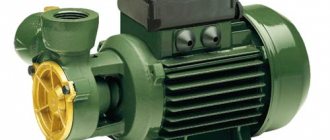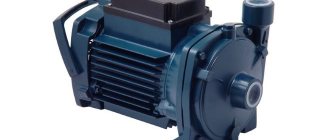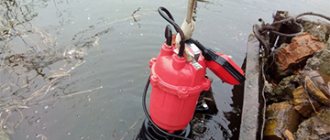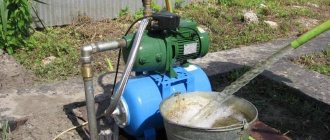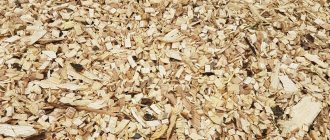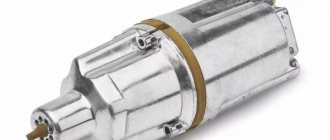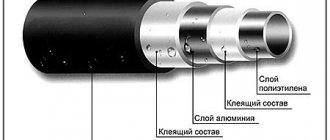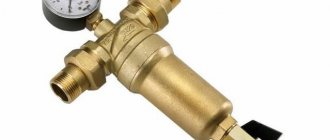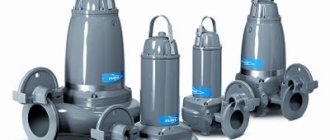Owners of personal plots and country houses quite often face a common problem - deep groundwater.
Ordinary pumping equipment located on the surface is not always capable of raising water to the surface, so it is necessary to use ejector pumping stations. These devices are much more efficient and allow you to get water from depths of no more than 50 meters, and then pump it for the needs of users. In order to find out all the technical parameters, as well as the specific nuances of the correct use of such equipment, you just need to carefully read this article, which contains answers to almost all the questions that arise when installing similar equipment.
What it is
An ejector is a fairly small but very effective device with a simple design, so some users make it themselves. This is especially effective when the farm already has a pumping station with a powerful pump of various types. With an ejector, the equipment allows you to effortlessly pump out clean water from a depth of 25 to 40 meters or more.
By using such additional equipment, each user saves money that would otherwise be spent on purchasing expensive equipment. If you do not yet have a similar station, but have just dug a well, then immediately purchase a product equipped with an ejector.
Types of ejector devices
According to their design and operating principle, ejector pumps can belong to one of the following categories.
Steam
With the help of such ejector devices, gaseous media are pumped out of confined spaces and a rarefied state of air is maintained. Devices operating on this principle have a wide range of applications.
Steam ejector for turbine with oil cooler
Steam jet
In such devices, the energy of a steam jet is used to suck gaseous or liquid media from a confined space. The operating principle of this type of ejector is that steam escaping from the nozzle of the installation at high speed carries with it the transported medium exiting through an annular channel located around the nozzle. Ejector pumping stations of this type are used primarily for rapid pumping of water from the premises of ships for various purposes.
Installation of water heating using a steam jet ejector
Gas
Stations with an ejector of this type, the operating principle of which is based on the fact that the compression of a gas medium, initially under low pressure, occurs due to high-pressure gases, are used in the gas industry. The described process takes place in the mixing chamber, from where the flow of the pumped medium is directed to the diffuser, where it is slowed down, and hence the pressure increases.
Air (gas) ejector for chemical, energy, gas and other industries
Principle of operation
The ejector design consists of the following elements:
- suction chamber;
- the node where mixing occurs;
- diffuser;
- the nozzle is at the narrowest part.
The last part is a pipe with a strongly narrowed end, due to which the liquid receives additional acceleration and is released from the device at high speed.
According to Bernoulli's law, such a flow exerts a slight pressure on its surroundings, then it enters the mixer, where a significant vacuum is created, due to which additional volumes of water begin to flow from the suction chamber. Having united into a single flow, the liquid passes through the diffuser further into the pipeline.
In a similar design, the kinetic energy of a flow moving at a huge speed is transferred to media that have a much lower speed, while new volumes of liquid are captured and transferred from the well through a pipeline to the place where the water flow is distributed throughout the entire area. A pumping station with a remote ejector is equipped with two pipes: for injection and recirculation.
A similar design will allow the user to spend less energy, and to regulate the volume of returning flows, it is necessary to install a valve in the recirculation line, which will allow the efficiency of the entire system to be adjusted to the desired level. Excess water is supplied to the consumer for his needs; the amount of incoming moisture per unit of time determines the performance of the entire system.
By using less electric motor power for the pump, the user saves energy resources. In addition, the ejector greatly facilitates the initial start-up of the entire system, because with a very small volume of water, it creates the necessary vacuum in the pipeline and performs the first intake of water, eliminating idle operation of all equipment.
Operating principle of the ejector
The ejector design includes several elements - an ejecting water inlet pipe with a tapering nozzle and a main pipe with a side pipe for the ejected medium, a mixing chamber, a cylindrical neck, an expanding diffuser and an outlet pipe.
When ejecting water is supplied under pressure to the ejector, its speed in the nozzle increases sharply. In this case, a rarefaction zone is created in the mixing chamber and ejected water or gas begins to flow into it. Both media are mixed and, under pressure slightly less than the initial one at the entrance to the ejector, enter the output of the device.
Most submersible pumps purchased by private homeowners provide reliable operation at an aquifer depth of 7-10 m. Connection to an ejector circuit allows for reliable water supply from a depth of up to 20-40 m.
Varieties
Pumping stations equipped with such original devices are available in two types:
- The ejector is located inside the structure. The entire structure has very compact dimensions, the vacuum is created artificially, and the recirculation line is located inside the product. For efficient operation, a high-power electric motor is required to ensure that the pump operates at high speeds, creating the required suction force.
Advantages of this design:- the product is less sensitive to foreign impurities that may be in the water;
in this case, the liquid supplied for the user’s needs does not need to be additionally filtered;
- the station provides the required pressure for all household needs of the consumer - you can water the area and use water inside the house at the same time.
Negative qualities:
- the equipment creates noise during operation;
- For installation, you need to equip a place with soundproofing or move the station further from the house.
The second option does not solve all problems, because neighbors will complain about noise, so sound insulation is also needed in this case, plus the cost of insulation - you need to equip a standard caisson.
Pros:
- the design allows water to rise from a depth of up to 50 meters;
sound impact is significantly reduced;
Minuses:
- productivity decreases;
- there are slight restrictions on the choice of diameter for the general pipeline.
Design Features
Like any other type of pump, injection models have two main parts: the pump part itself and the electric motor that drives it.
General view of an automatic ejector-type pumping station
Let us list the main design features of injection equipment that distinguish it from other types of units.
- Almost every model has a check valve, which is designed to prevent water from flowing back through the device when it is turned off.
- A special float switch turns off the electric motor in cases where the water level in a well or other hydraulic structure drops. The presence of such a switch protects the pump from running dry, which can lead to its failure.
- The electric motor with which the injection-type pump is equipped is not immersed in water, but is installed in a dry place - on the shore of a reservoir, next to a well or well. In this case, only that part of the pump that is responsible for the rarefaction of air is in the water.
- In the design of injection-type pumps, there is not one discharge pipe, but two suction pipes of different diameters, at the end of each of which a special device is installed - an injector. It is thanks to the presence of such injectors that pumps of this type are capable of pumping water from wells of considerable depth.
- In order for injection-type pumping stations to function normally during the cold season, they are placed in insulated pits or in special caissons.
Installation diagram of the ejector pump
When choosing a place to install an engine that will drive an injection-type pump, two main parameters should be taken into account:
- the depth of the well from which water is to be pumped out;
- the distance of the well from the point to which water must be supplied.
Since lifting water from a well in a vertical direction requires more energy than moving it horizontally, they try to locate the drive motor of the injection pump closer to the well in order to make maximum use of its power.
Connection
In the case of a built-in ejector, installation of equipment is not difficult: it is enough to connect the pipeline from the well to the suction inlet, check the hydraulic accumulator and the operation of the automation, which is responsible for autonomous control of the entire system.
With an ejector outside the station, additional installation steps are added:
- we lay a recirculation line from the pressure station, and connect the main pipe from the ejector to the suction pipe of the pump;
- We must connect a check valve to the ejector suction so that the liquid does not flow out by gravity when the pump stops, as well as a filter element so that only clean water continues to flow.
As mentioned earlier, a valve can be inserted into the recirculation line for adjustment, and some designs already have such a device; its placement and adjustment methods are indicated in the operating instructions.
Making an ejector
Having understood what an ejector is and having studied the principle of its operation, you will understand that you can make this simple device with your own hands. Why make an ejector with your own hands if you can purchase one without any problems? It's all about saving. Finding drawings from which you can make such a device yourself does not present any particular problems, and to make it you do not need expensive consumables and complex equipment.
How to make an ejector and connect it to the pump? For this purpose you need to prepare the following components:
- female tee;
- union;
- couplings, elbows and other fitting elements.
Components for a homemade ejector
The ejector is manufactured according to the following algorithm.
- A fitting is screwed into the lower part of the tee, and this is done so that the narrow branch pipe of the latter is inside the tee, but does not protrude from its reverse side. The distance from the end of the narrow branch pipe of the fitting to the upper end of the tee should be about two to three millimeters. If the fitting is too long, then the end of its narrow pipe is ground off; if it is short, then it is extended using a polymer tube.
- An adapter with an external thread is screwed into the upper part of the tee, which will connect to the suction line of the pump.
- A bend in the form of an angle is screwed into the lower part of the tee with the fitting already installed, which will connect to the recirculation pipe of the ejector.
- A bend in the form of an angle is also screwed into the side branch pipe of the tee, to which a pipe supplying water from the well is connected using a collet clamp.
Homemade ejector assembly
All threaded connections made during the manufacture of a homemade ejector must be sealed, which is ensured by the use of FUM tape. On the pipe through which water will be drawn from the source, a check valve and a mesh filter should be placed, which will protect the ejector from clogging. For the pipes with which the ejector will be connected to the pump and storage tank, which ensures water recirculation in the system, you can choose products made from both metal-plastic and polyethylene. In the second option, installation does not require collet clamps, but special crimping elements.
After all the required connections are made, the homemade ejector is placed in the well, and the entire pipeline system is filled with water. Only after this can the first start-up of the pumping station be carried out.
Rating of the best models
Caliber SVD-770Ch+E
pros
- An excellent purchase for a summer cottage or country house
- works at 5 plus, normal cost
Minuses
- plastic thread at the connection point
From 7390 ₽
The model was developed by domestic engineers, but is produced in Chinese factories, which is why there are some shortcomings: the plastic threads on the connections will not last long - they must be changed immediately, and this is an additional expense.
Grundfos JPD 4-47 PT-V
pros
- compact size, quiet operation
- A well-known company makes high-quality equipment
Minuses
- not found
From 13234 ₽
This model is designed for private buildings to normalize the pressure inside the home water supply during frequent changes, and copes well with pumping water from deep wells.
SPERONI APM 150/25
pros
- high-quality assembly, quiet but very productive work
- pumps water from deep wells without tension
Minuses
- not found
From 20800 ₽
The model is made of high quality materials, has automatic engine protection against overloads and operation without water, and is used in domestic and industrial water supply systems.
Marina APM 200/25
pros
- low energy consumption
- body and all parts made of corrosion-resistant metal
Minuses
- not found
From 24230 ₽
The model is designed for pumping only clean water without impurities from great depths; it works perfectly with wells no more than 50 m deep.
Top Aqua AUJCB-800 ejector
pros
- compact size and light weight
- easy installation and simple use
Minuses
- not found
From 6450 ₽
The model is designed for pumping water from wells or boreholes no deeper than 20 m, only for clean liquid with an impurity content of no more than 50 g/cubic meter. m.
